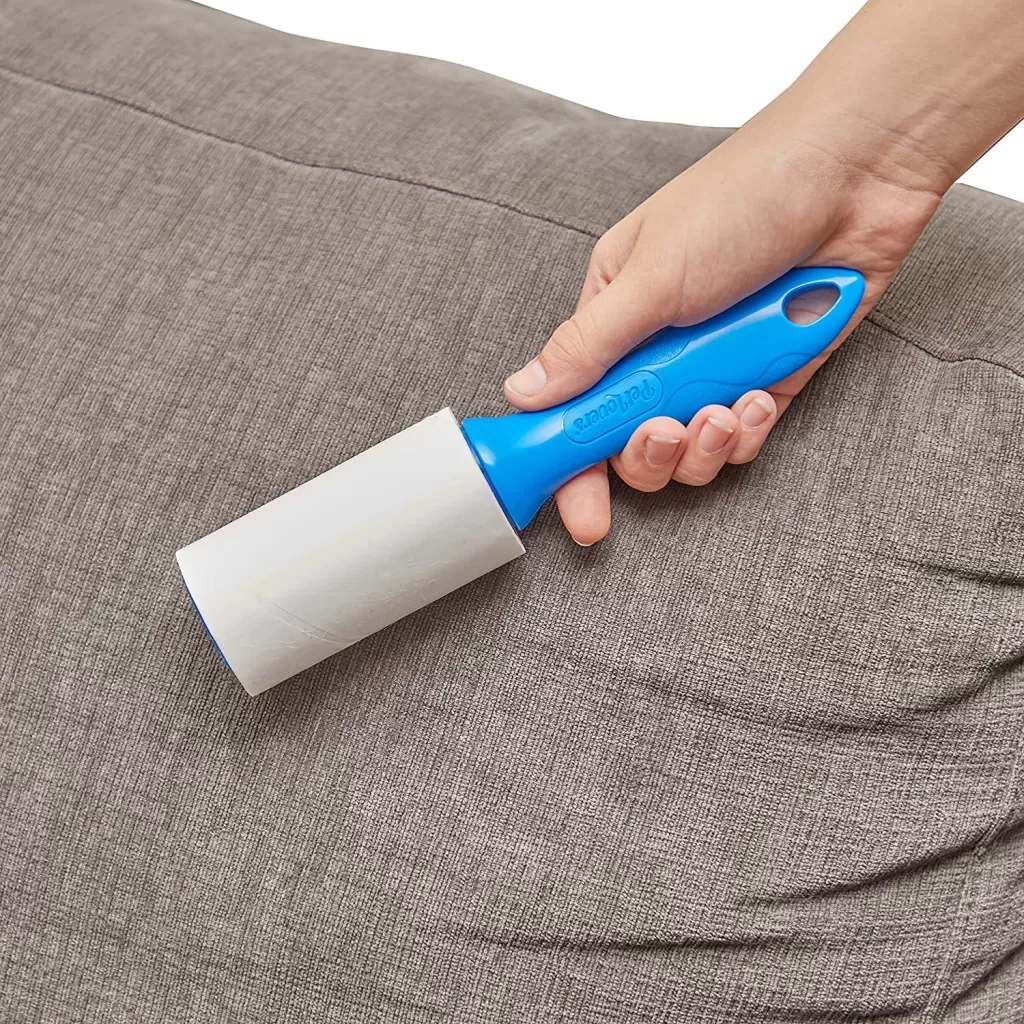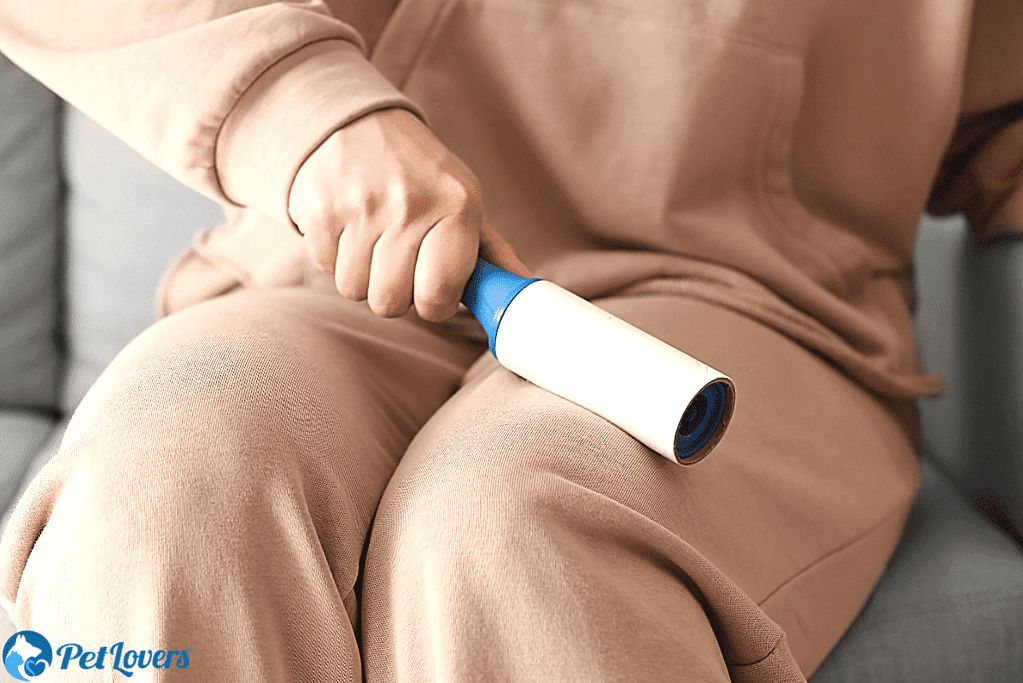Types Of Dog Brushes
Grooming your dog regularly helps minimize shedding, control where that loose hair falls, and improve the health of your dog’s

Imagine heading out for a job interview in a blue suit and noticing last minute it’s covered in hair or worse on a first date. Beyond the stress, this is one of the worst things that can happen to your clothing, and the culprit is lint.
These little balls of fabric make clothing look old and unkempt, and you must take action. If you are looking for how to remove lint from clothes, here are some of the many ways you can do it.
Table of Contents
A lint roller is the best option and is ready-made for this job. Lint rollers work in almost the same way as using sticky tape would do, albeit much cleaner, easier, and more effective.
Simply move the lint roller over your clothes and watch it pick up all of the lint, pet hair, and other debris. Once full, peel off the roller sheet, revealing a new one underneath. PetLovers makes the best lint roller on the market and it’s sold in a multitude of pack sizes.

One of the simplest ways to quickly get the lint off your fresh clothes is to use wide sticky tape. The best approach is to wrap it around your hand a couple of times, sticky side up. Once you have done this place your hand over the affected area and lift, repeating until the tape gets full. If needed, repeat this step until all of the lint has come off the fabric.
Not all lint on clothing is hard to remove, and sometimes a gentle lint brush will remove any that has built up. You must be careful when brushing as if you are too vigorous, you may pull threads out from the fabric.
In doing this you will not only remove the problematic lint but potentially pull out thin pieces of the material as you go. This will damage your clothes and increase the chances of having lint problems in the future.
A pumice stone is more commonly used for getting dry skin off your feet and hands, but it can also double up as a great lint remover. This is especially true for removing stubborn lint that just won’t shift.
This option works best on items like fleeces or well-made sweaters. Thin materials can become damaged with the use of a pumice stone, even if you are gentle when you use it.
Be sure to go with the weave of the fabric when rubbing the stone over it, and remember to only put light pressure on it when you do. Rubbing repeatedly can cause a hole in the fabric, so just look to go over an area twice at most when trying to remove the lint.
Using a hair dryer on your clothing is a good first step, as it will get rid of loose lint and any dust or debris that may have gathered. If you put your clothes on and realize that you have some excess fabric or lint, give them a blast with the dryer on the cool setting.
You’ll find that a lot of the lint comes off very easily, giving you a clean and fresh look without much effort. Using air to get rid of lint will also ensure that you maintain the integrity of your clothes as well.
Some of the lint that you find on your clothing will be threads that have wrapped around one another, creating that lumpy effect. Much of it, however, will be attached to the clothing with static, and this can be easier to remove.
Using an antistatic spray is the perfect option here, as it will remove a lot of the top layer of lint, with just a couple of squirts. There may be some remaining lint afterward, but the spray should remove the majority.
You can purchase antistatic spray at the grocery store, or make your own at home. For a DIY antistatic spray, simply mix 1 part rubbing alcohol with 1 part fabric softer in a bottle. Mix this with 2 parts of water and give it a good shake. Make sure to test any antistatic sprays on a small nonvisible part of your clothing or fabric to make sure it doesn’t stain.
A fine way for you to both lose a little lint from your clothing and avoid its buildup is to wash your clothes inside out. When different fabrics rub together in the washing machine, microfibers from each can become entwined, causing those pesky lint issues.
If you turn most clothing inside out, it will prevent a lot of friction because of the way that clothing is woven. This is also beneficial because even if you do create lint in the washing machine, it will be on the inside of the garment and therefore not visible.
Distilled white vinegar is a miracle product for so many jobs in the home. It should come as no surprise then that it’s also a great way to prevent lint fuzz on your clothing. Simply add 1/4 of a cup of white vinegar to your wash.
This will greatly reduce the likelihood of lint building up on your clothes, and will also help to unstick some of the lint that is already there. Removing lint with white vinegar is kind to your clothes and highly effective.
If you are having an issue with lint on your clothing then you should first put your washing machine on a self-clean cycle. Once the machine is clean, it is important that you only purchase detergent which is specialized in lint removal.
Not everyone uses liquid fabric softener when washing clothes, but you should if you have lint problems. As the name suggests, this product will soften the fabric and reduce the chance of lint issues.
Air drying wet clothes should always be your number one option, instead of using the dryer. This is kinder to the environment and your clothes will smell great. Another benefit of air drying is that the wind will naturally help to remove small pieces of lint. This will leave your clothing dry, smelling fresh, and lint-free.
If you must use the dryer on cold or rainy days, be sure to add a dryer sheet in with the items. Most dryer sheet packaging will suggest that you only use one sheet, but we prefer to add a second for the best results. Many think that the dryer sheets are only used to add a nice scent to the clothing, but there is more.
These sheets also help to remove static in the dyer, and as we have mentioned this is what causes lint to collect in the first place. Adding a dryer sheet can help to remove some lint, and will certainly prevent its buildup.
Now that we have established how you can remove the lint that is on your clothing, let’s take a look at some ideas as to how you can stop it from getting there in the first place.
Many people sort laundry into lights and darks to prevent colors from running, which makes perfect sense. What you should also be doing is separating certain materials, preventing lint from getting on clothes.
This is because some fabrics attract lint, and others such as spandex are most lint resistant. Fabrics like nylon, linen, corduroy, and other synthetics, are prone to attract loose threads. Other fabrics such as cotton, chenille, fleece, and towel, should be kept separate.
Split these fabrics up when you wash them, and keep lint-attracting clothes separate from the rest. Once you do this you will notice a significant reduction in the amount of lint that you see on your clothing.

As we have already established, making sure that your washing machine and dryer are clean is essential in your fight against lint. Each time that you use either machine, microfibers are removed from clothing and fail to drain.
These small threads remain in the drum, lint trap, or tubes, and they get back into the next cycle. As you can imagine, this is a key contributor to lint getting on clothes.
Almost all washers and dryers have self-clean cycles, so be sure to use them at least once a month. If your washer or dryer doesn’t have this cycle, you can still give it a clean.
You will need to wash the drum out by hand, and then set it to any cycle but leave the drum empty. In doing this you should be able to remove many of the microfibers that have built up.
Make sure to keep your dryer’s lint screen or lint filter clean as they may build up and you may end up with lint-covered clothes.
The ‘low heat’ or ‘air drying’ setting on your dryer is the closest that you will get to air drying your clothes, without actually hanging them outside. This may not have the same impact on reducing lint as air drying, but it will make a big difference.
Static is created in the machine through heat and dry conditions. As we have established, static causes fabrics to attract, creating lint. If you dry your clothes on a low heat setting you can minimize the static energy and reduce the amount of lint that you see on your clothing.
 PetLovers
PetLovers
Grooming your dog regularly helps minimize shedding, control where that loose hair falls, and improve the health of your dog’s
Have you begun to notice a little more cat fur around the home than you are used to? Most cat
A slicker brush is one of the most essential tools in your dog grooming arsenal. This product can do it
TO GET 15% OFF ON ALL YOUR PURCHASES